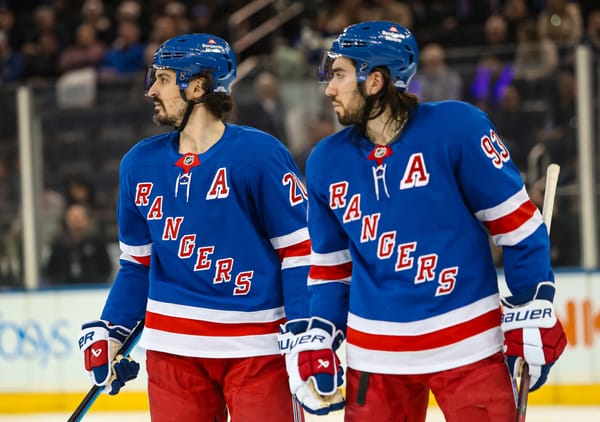Skjei’s postseason excellence
Brady Skjei was arguably the Rangers best defenseman in the playoffs. Ryan McDonagh and Dan Girardi played tougher minutes against the big guns on the Canadiens and Senators, but Skjei shined in his limited role.
It was no secret that the Rangers needed their blue line to step up in the playoffs. The big stage didn’t keep New York’s youngest defender from rising to the occasion when it mattered most.
“I think I have the abilities to do that,” Skjei told the New York Post during the Montreal series. “I think my skating allows me to do some things some other guys can’t. I’m also a pretty big guy and I can play the physical game when I have to. So I think I could be a pretty good playoff performer.”
Sometimes in high pressure situations we end up getting a diamond. We already knew Skjei was something special after the regular season, and the crucible of the Stanley Cup Playoffs only reaffirmed that.
Against Montreal Skjei built off of his underappreciated regular season. While the media spun narratives around the 2009 Ryan McDonagh trade, Chris Kreider's collision with Carey Price and the goaltending duel, Skjei was consistent, dangerous and dynamic on the blue line.
The rookie defeneseman was decisive with the puck, rarely beaten one-on-one and finished with a -1 penalty differential in his second Stanley Cup Playoffs. The discipline he showed with the puck and with his temper is praiseworthy. They were both aspects of his game that attracted criticism from fans and the media during the regular season.
The stat that most Rangers fans will remember about Skjei’s 2017 Playoffs is the four goals he scored. The rest of New York’s blue line scored four goals combined (McDonagh and Nick Holden each had two).
All four of Skjei’s goals came at even strength despite the fact that he ranked fourth on the blue line in average even strength ice time per game. It’s true that he enjoyed a high shooting percentage, but there was a lot more going on than just good luck.
When Skjei was on the ice good things happened for the Rangers. It wasn’t a coincidence and it wasn’t all puck luck. Skjei proved to be the most effective Blueshirt blueliner in generating controlled zone exits. That made the Rangers a more dangerous team in the transition game when he was on the ice.
As a postseason pairing Skjei and Brendan Smith led all defensive pairs in the league in 5-on-5 team scoring chances for and goals for (at the time of the Rangers elimination). Competing against two teams that weren’t as wealthy in forward talent as the Rangers played a role in that. But the Skjei-Smith pairing’s ratio of goals for vs goals against and scoring chances for vs scoring chances against paints a clear picture of how effective the duo was.
Skjei had five primary points in this year’s playoffs. Five primary points in 12 games.
We haven’t seen a rookie defenseman make that kind of impact on the team’s offense in the playoffs in a long time. McDonagh scored one goal in his first 37 playoff games with the Rangers. Marc Staal? Two goals in his first 22 games. Girardi? Zero goals in his first 33 games. Michael Del Zotto had three goals in his 32 postseason games with New York.
And Skjei’s postseason was about so much more than scoring four goals and shooting 21.1 percent. He found a way to be physical and stay disciplined - something that often eludes young defensemen in the postseason. He opened the ice up and made the Rangers more dangerous on the rush with his skating ability. He made big plays in big games and gave Rangers fans cause for optimism about the future of the blue line.
If you’ve been searching for a silver lining after the Rangers early playoff exit, Skjei is your answer.
The promise that he showed this postseason is cause for optimism about the the team’s greatest weakness. He’s 23-years-old, big, strong, skates far too well for someone with his size and is showing signs of being an outstanding puck-moving defenseman.
Special thanks to Shayna Goldman for putting together the .gifs used in this piece!




